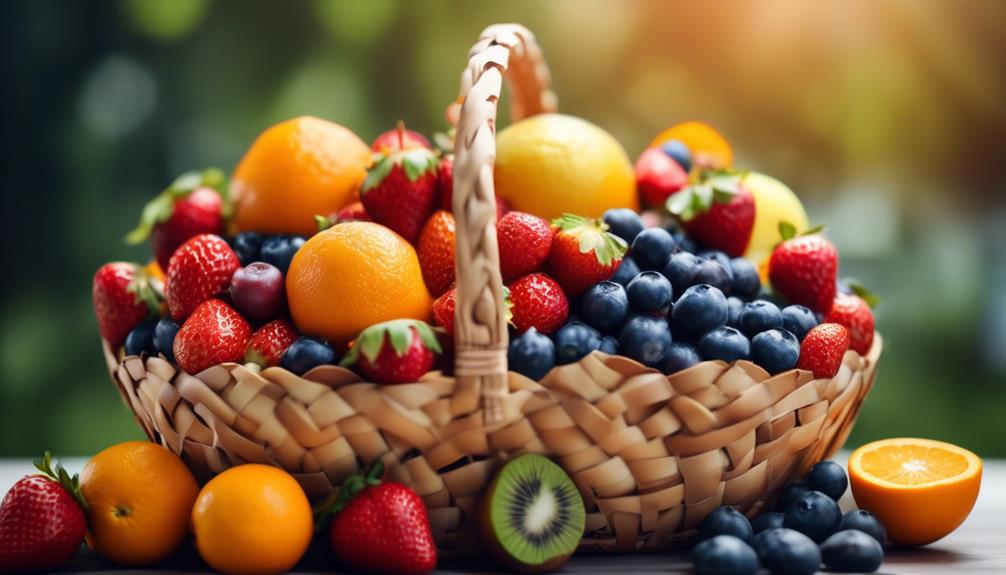What to Do to Limit Sugar Intake in Your Child's Diet

Limiting your child's sugar intake is crucial for their health.
Make simple changes to their beverages, include more fruits and vegetables, and choose whole foods over processed ones to create a healthier lifestyle.
Understand the Impact of Sugar on Children
Understand the impact of sugar on your child's health by recognizing its detrimental effects on their overall well-being. Sugar, especially added sugar, can have a negative impact on children's health. It's important to be aware of the amount of sugar your child consumes and take steps to reduce their sugar intake.
Children's sugar intake should be limited to a certain amount of grams of added sugar per day. The American Heart Association recommends that children aged 2-18 should consume no more than 25 grams (6 teaspoons) of added sugar per day. However, studies have shown that children often exceed this recommendation, with some consuming up to 3 times the recommended amount.
High intake of added sugar has been linked to various health issues in children, including obesity, type 2 diabetes, dental cavities, and poor nutrition. Sugar provides empty calories and lacks essential nutrients, leading to weight gain and increased risk of chronic diseases.
To reduce sugar in your child's diet, it's important to make smart food choices. Opt for healthier alternatives to sugary drinks, such as water and plain low-fat milk. Increase consumption of fruits and vegetables, which provide fiber and essential nutrients while reducing sugar intake. Choose whole foods over processed foods, as they're less likely to contain added sugars.
Educate Yourself About Hidden Sources of Sugar
To limit sugar intake in your child's diet, it's important to educate yourself about hidden sources of sugar. Pay attention to food labels and look for added sugars in products like sauces, dressings, and granola bars.
Be aware of terminology used for added sugars, such as corn syrup, dextrose, fructose, and honey. By understanding these hidden sources, you can make informed choices and find healthier alternatives for your child.
Label Reading Tips
To educate yourself about hidden sources of sugar in foods, start by checking the ingredient list for terms such as sugar, corn syrup, dextrose, fructose, honey, or molasses. This will help you identify added sugars that may be hiding in your Childs' foods.
It's important to be aware that even seemingly healthy foods can contain high amounts of added sugar. For example, 100% fruit juice may contain a lot of sugar. To make things easier, pay attention to the 'Includes (X)g Added Sugars' on the label, as this will show you the amount of extra sugars added during processing.
Opting for natural, unprocessed foods can help eliminate added sugars from your Childs' diet. Remember, the American Heart Association recommends that children consume less than 25 grams (6 teaspoons) of added sugar per day.
Sneaky Sugar Sources
When it comes to hidden sources of sugar in your child's diet, it's important to be well-informed and vigilant. Here are three sneaky sugar sources to watch out for:
- Sugary drinks: Be mindful of beverages like soda, fruit punch, and sports drinks, as they're loaded with added sugar. Opt for healthier alternatives such as water, plain low-fat milk, and whole fruit over fruit juice.
- Processed foods: Many processed foods, such as cereals, granola bars, and yogurt, contain high amounts of added sugar. Choose whole foods over processed options to eliminate added sugars and prioritize better nutrition for your child.
- Hidden sugars: Sugar can hide in unexpected places, such as condiments, salad dressings, and sauces. Read food labels carefully to identify added sugars and choose products with lower sugar content.
Healthy Alternatives
Are you aware of the hidden sources of sugar in your child's diet? It's important to educate yourself about these sneaky sources and find healthy alternatives to reduce your child's added sugar intake. Here are some ideas for nutritious snacks that are low in added sugar:
| Category | Healthy Snack Options |
|---|---|
| Fruits | Fresh or frozen berries, sliced apples with nut butter, or grapes |
| Dairy | Plain yogurt with no added sugar or artificial sweeteners, or cheese cubes |
| Grains | Whole grain crackers or rice cakes |
Set Clear Guidelines for Sugar Consumption
Setting clear guidelines for sugar consumption is essential in promoting a healthy diet for your child. By establishing these guidelines, you can effectively reduce their intake of added sugars, which are high in empty calories and can negatively impact their weight management. Here are three important steps to consider:
- Substitute sugary drinks: Encourage your child to drink water or plain low-fat milk instead of sugary beverages like soda or fruit-flavored drinks. These drinks are often high in added sugars and provide little to no nutritional value. By making this simple switch, you can significantly reduce their daily added sugar intake.
- Choose whole fruits over fruit juice: While fruit juice may seem like a healthy choice, it can contain a significant amount of sugar. Opt for whole fruits instead, as they provide more fiber and fewer grams of sugar. This can help your child feel fuller for longer and reduce their overall sugar consumption.
- Educate and set clear limits: Take the time to educate your child about the impact of sugar-sweetened beverages on their health. Explain why it's important to limit their intake and set a clear guideline to restrict added sugars to no more than 5% of their daily calories. Adjust the gram amount based on their specific calorie needs.
Make Healthier Alternatives Readily Available
To make healthier alternatives readily available for your child, stock up on a variety of fruits that can serve as convenient and nutritious snacks. Consider making homemade smoothies using fresh fruits and low-sugar yogurt options as a healthier alternative to sugary beverages.
Fruits as Snacks
Make healthier alternatives readily available by keeping a variety of fresh fruits on hand for snacking. This is an effective way to limit added sugar in your child's diet.
Here are three reasons why fruits make great snacks for your little ones:
- Nutritional Value: Fruits are packed with essential vitamins, minerals, and fiber that are beneficial for your child's growth and overall health. They provide natural sugars that are less harmful than added sugars found in processed snacks.
- Convenience: By washing, cutting, and having fruits ready to eat in the fridge, you make it easy for your child to choose whole fruits over sugary treats. Having them readily available encourages healthier snacking habits.
- Variety: Dried fruits, such as raisins, apricots, or banana chips, can be stocked up as convenient and healthier snack options. Additionally, you can prepare fruit salads, fruit kebabs, fruit smoothies, or frozen fruit popsicles for a fun and appealing way to present fruits as snacks.
Homemade Smoothies
Creating homemade smoothies with natural ingredients is a fantastic way to offer healthier alternatives and limit added sugars in your child's diet. By preparing these low-sugar drinks at home, you have control over the ingredients, ensuring that your child receives the necessary nutrients without the excessive sugar found in store-bought options. Keep a variety of fresh fruits and vegetables readily available to blend into these nutritious smoothies. Substitute sugar-laden recipes with natural sweeteners like honey, agave, or dates. Incorporate nutrient-dense ingredients such as Greek yogurt, chia seeds, and spinach for added health benefits. Encourage your child to participate in making homemade smoothies to instill healthy eating habits. Check out the table below for some delicious homemade smoothie ideas that will satisfy your child's sweet tooth without the added sugar.
| Smoothie Flavor | Ingredients |
|---|---|
| Strawberry-Banana | Fresh strawberries, ripe bananas, Greek yogurt, almond milk, honey |
| Tropical Paradise | Pineapple, mango, coconut milk, Greek yogurt, spinach, agave |
| Berry Blast | Mixed berries (blueberries, raspberries, blackberries), Greek yogurt, almond milk, chia seeds, dates |
| Green Machine | Spinach, kiwi, avocado, almond milk, Greek yogurt, honey |
| Chocolate Banana | Frozen banana, cocoa powder, almond butter, almond milk, dates |
Low-Sugar Yogurt Options
Now let's shift our focus to providing healthier alternatives for your child's yogurt choices by ensuring low-sugar options are readily available.
Here are three ways you can make low-sugar yogurt options more accessible for your child:
- Stock up on Greek yogurt or plain yogurt without added sugars: These options are lower in sugar compared to flavored yogurts and are a great source of protein and calcium.
- Keep healthier yogurt alternatives visible and accessible: Place them in the front of the fridge or pantry, making it easier for your child to choose them over high-sugar options like ice cream.
- Enhance the flavor of plain yogurt with natural sweeteners: Encourage your child to add fresh fruit, a drizzle of honey, or a splash of maple syrup. This way, they can enjoy a tasty, low-sugar snack while still getting the benefits of yogurt.
Encourage Water as the Main Beverage
Encourage your child to make water their go-to beverage throughout the day, avoiding sugary drinks like sodas and fruit juices. By promoting water as the main beverage in your child's diet, you can significantly reduce their sugar intake. Water is a healthy and hydrating choice that has no added sugar or calories. To illustrate the importance of choosing water over sugary drinks, let's compare their sugar content in a table:
| Beverage | Sugar Content (per 8 oz) |
|---|---|
| Soda | 26 grams |
| Fruit Juice | 24 grams |
| Sports Drink | 21 grams |
| Flavored Milk | 12 grams |
| Sparkling Water | 0 grams |
As you can see, water and sparkling water have zero grams of sugar, making them the best options for quenching your child's thirst. It's important to note that even 100% fruit juice contains a significant amount of sugar, so it's better to offer whole fruits instead, which provide hydration along with fiber. By encouraging your child to choose water as their main beverage, you can help them develop healthy eating habits and reduce their consumption of sugary foods and drinks. Remember, small changes like this can have a big impact on your child's overall health.
Limit Sugary Snacks and Desserts
To continue promoting a healthy and low-sugar diet for your child, it's important to address the topic of limiting sugary snacks and desserts. Here are three key strategies to help you accomplish this:
- Offer whole fruits as a healthier alternative to sugary snacks and desserts. Fruits contain natural sugars, but they also provide essential vitamins, minerals, and fiber. A piece of fruit, such as an apple or a banana, can satisfy your child's sweet tooth while providing important nutrients.
- Limit or eliminate sugary treats like candy, pastries, and ice cream from your child's diet. These foods are often high in added sugars and offer little nutritional value. Instead, opt for healthier options like yogurt with fresh fruit or homemade fruit sorbet. These alternatives can still satisfy your child's cravings for something sweet without the excessive amount of sugar.
- Be mindful that even 100% fruit juice contains a lot of sugar, so opt for whole fruits instead. While fruit juice may seem like a healthier option, it can still contribute to your child's daily sugar intake. It's best to encourage your child to eat the whole fruit instead, as it contains fiber that can help regulate blood sugar levels and promote a feeling of fullness.
Lead by Example and Be a Role Model for Healthy Eating Habits
Setting a positive example for your child's eating habits starts with making healthy choices yourself. By being a role model and leading by example, you can teach your kids the importance of healthy eating habits and help your family limit sugar intake. Here are some ways you can demonstrate healthy eating habits:
| Choose healthier beverage options | Make fruits and vegetables a regular part of meals and snacks | Opt for natural, unprocessed foods | Cook at home and make healthier choices when eating out |
|---|---|---|---|
| Select water and plain low-fat milk instead of sugary drinks. | Incorporate fruits and vegetables into meals and snacks to showcase their nutritional value. | Prioritize whole grains, lean meats, poultry, fish, and nuts over processed foods. | Emphasize mindful eating and portion control by cooking at home and making healthier choices when dining out. |
In addition to these actions, it is essential to plan and pack healthy snacks ahead of time. Avoid sugary options and instead focus on providing fruits, vegetables, nuts, and trail mix for your family. By consistently making healthy choices and showing your children the benefits of nutritious foods, you can lead them towards a lifetime of healthy eating habits and limit their sugar intake.
Frequently Asked Questions
How Do I Stop My Child From Sugar Craving?
To stop your child's sugar cravings, set boundaries and offer healthy snack alternatives like fruits and veggies. Educate them about the effects of sugar and create a balanced meal plan. Encourage physical activity and reward with non-food treats.
What Are 5 Ways You Can Limit Sugar Intake?
To limit sugar intake, try healthy snack alternatives like fruits and veggies. Set boundaries and rules about sugary treats. Teach kids about the negative effects of sugar. Encourage water and physical activity. Lead by example.
How to Sugar Free Kids?
To sugar-free kids, focus on healthy substitutes like water and low-fat milk. Provide sugar-free snacks and balance meals with whole fruits and veggies. Read labels, educate kids, and set a good example.
How Do You Limit Sweets for Kids?
To limit sweets for kids, you can offer healthy alternatives, set boundaries, educate them about sugar, plan meals, encourage water consumption, and lead by example.









